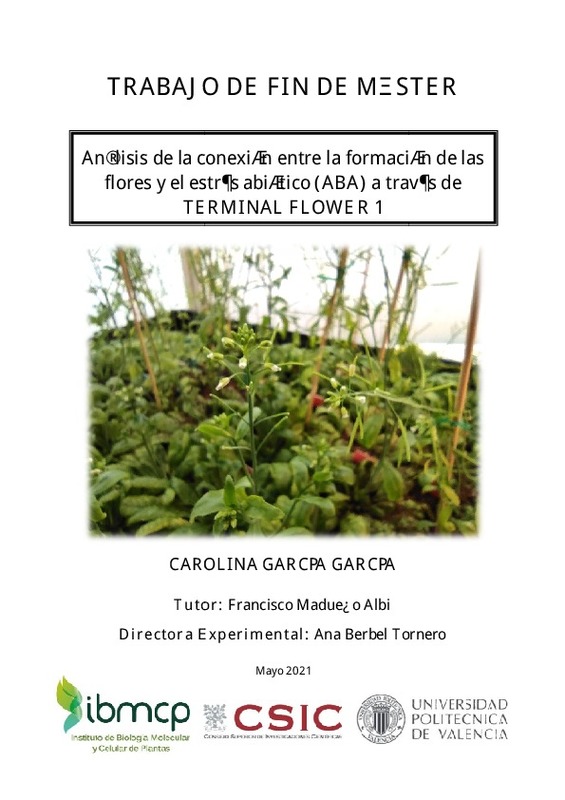|
Resumen:
|
[EN] Plant architecture s defined as the tridimensional spatial disposition of plant organs after their
development and differentiation. This arrangement plays a key role in the ecology of plants and
their interaction ...[+]
[EN] Plant architecture s defined as the tridimensional spatial disposition of plant organs after their
development and differentiation. This arrangement plays a key role in the ecology of plants and
their interaction with the environment that surrounds them.
In the model plant Arabidposis thaliana every organ formed in the aerial part, besides
cotyledons, are derived from the SAM (Shoot Apical Meristem). Its development can be divided
in two phases: the vegetative phase, when the vegetative meristem produces leaves in a rosette
with little elongation of the internodes; and the reproductive phase, when it starts producing
flowers instead of vegetative organs. The switch between them is known as “floral transition”,
and it will be a crucial step for survival as well as for the reproductive success of the plant.
Thus, this process is regulated by a plethora of signals, both endogenous and exogenous,
making sure the process takes place in suitable conditions.
During floral transition, the SAM becomes an inflorescene meristem, entering the phase of
reproductive development and giving rise to the inflorescence. When flowering is activated
through the photoperiodic rute the genetic regulation is carried by two key integrators:
FLOWERING LOCUS T (FT) and TERMINAL FLOWER 1 (TFL1). Both genes translate into
proteins of the PEPBs family, but with opposite functions. While FT promotes flowering and
induces floral identity genes; TFL1 represses flowering, controlling the spatial identity of the
meristem, as well as the transition phase.
The molecular function of TFL1 is not yet well understood. In previous experiments carried out
in this laboratory, some target genes of TFL1 were identified through a ChIP-seq analysis, some
of them being part of the abscisic acid (ABA) signaling pathway. The relationship between
ABA and flowering is not unheard of; however its exact contribution is still poorly understood,
since it has been recorded to have both positive and negatives roles related to flowering
regulation.
Nevertheless, the connection between TFL1 and ABA has not been studied yet, which opens the
door to some interesting questions. In this Master Thesis we aimed to deepen the knowledge
about the interaction between TFL1 and its target genes from the ABA signaling pathway. In
order to do so, we analyzed how TFL1 affects the expression of its target genes; we also
analyzed loss of function mutants and overexpression lines of some of these genes to study their
possible contribution to development processes regulated by TFL1.
[-]
[ES] La arquitectura de la planta se define como la disposición tridimensional que adoptan los
órganos de la planta tras su proceso de crecimiento y diferenciación. Esta conformación es de
vital importancia para la ...[+]
[ES] La arquitectura de la planta se define como la disposición tridimensional que adoptan los
órganos de la planta tras su proceso de crecimiento y diferenciación. Esta conformación es de
vital importancia para la ecología de las plantas y su interacción con el entorno que las rodea.
En el caso de la especie modelo Arabidopsis thaliana, todos los órganos formados en la parte
aérea, excepto los cotiledones, van a derivar del meristemo apical del tallo (SAM, Shoot Apical
Meristem). Este desarrollo se divide en dos fases: fase vegetativa, en la que el meristemo
vegetativo produce una roseta de hojas sin elongación de los entrenudos; y la fase reproductiva,
en la comienza a producir flores en vez de órganos vegetativos. El cambio de una a otra se
conoce como “transición floral”, y va a ser un proceso crucial para la supervivencia y el éxito
reproductivo de la planta. Como tal, se encuentra regulado tanto por señales endógenas como
por señales exógenas, asegurando que este proceso tenga lugar en condiciones adecuadas.
Durante la transición floral, el SAM adquiere identidad de meristemo inflorescente, entrando en
la fase de desarrollo reproductivo y dando lugar a la inflorescencia. Cuando la floración se
activa por la vía del fotoperiodo la regulación la llevan a cabo, entre otros, dos genes
integradores clave: FLOWERING LOCUS T (FT) y TERMINAL FLOWER 1 (TFL1). Ambos
genes dan lugar a proteínas de la familia PEBPs, pero con funciones opuestas. Mientras que FT
promueve la floración e induce genes de identidad floral; TFL1 reprime floración, controlando
así la identidad espacial del meristemo, así como la fase de transición.
La función molecular de TFL1 aún no está del todo clara. En experimentos previos llevados a
cabo en este laboratorio, se identificaron mediante ChIP-seq distintos genes diana de TFL1,
siendo varios de ellos componentes de la ruta de señalización del ácido abscísico (ABA). La
relación entre la floración y el ABA no es desconocida; sin embargo, la contribución exacta del
ABA a la transición floral es controvertida, ya que se han observado tanto papeles positivos
como papeles negativos.
No obstante, hasta ahora no se había relacionado a TFL1 con el ABA, lo cual genera varias
preguntas. En este Trabajo de Fin de Máster hemos intentado profundizar en la interacción
entre TFL1 y diferentes genes de la ruta de señalización del ABA. Para ello, hemos analizado
cómo TFL1 afecta a la expresión de estos genes diana; también hemos analizado mutantes de
pérdida de función y líneas de sobreexpresión de algunos de estos genes para estudiar su posible
contribución a los procesos de desarrollo controlados por TFL1.
[-]
|







